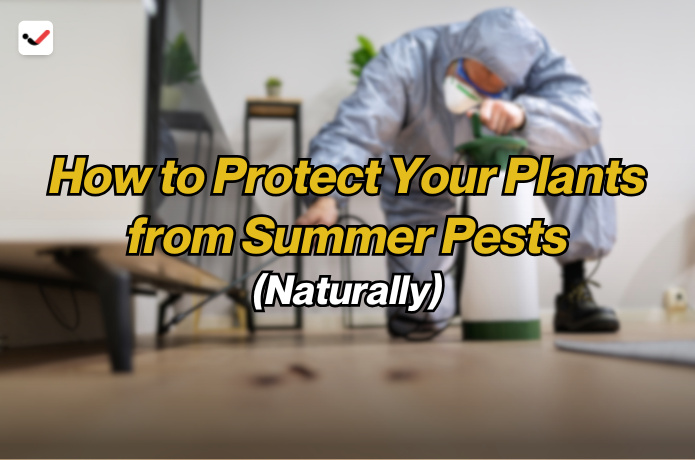How to Protect Your Plants from Summer Pests (Naturally)
How to Protect Your Plants from Summer Pests (Naturally)

Summer brings sunshine, warmth, and garden growth—but also a boost in summer plant pests. From aphids and whiteflies to squash vine borers and fungus gnats, these unwanted visitors can weaken your plants, reduce yields, and spoil the joy of gardening. Using natural pest control methods protects your garden and preserves important pollinators like bees and ladybugs. With easy, low‑cost solutions, you can defend your vegetables, herbs, and ornamentals safely and effectively.
In this guide, you’ll learn simple steps to shield your garden from common summer plant pests using organic pest control techniques. You’ll discover companion planting ideas, homemade sprays, beneficial insects, physical barriers, and more. All strategies use natural ingredients—no harsh chemicals—to support plant health while keeping pests away. By the end, you’ll have a healthy, pest‑free garden that thrives all summer long.
1. Spot Common Summer Plant Pests Early
Watch for signs of trouble: clumps of soft‑bodied insects like aphids or whiteflies, holes in leaves, sticky honeydew, wilting vines (often from squash vine borer), or tiny flies in soil (fungus gnats). Catching pests early lets natural pest control methods work best.
2. Use Companion Planting as Pest Shield
Plant herbs and flowers that repel pests or attract beneficial insects. Marigolds deter nematodes and aphids; basil wards off hornworms; mint, thyme, chives, garlic, and rosemary repel biting insects and cabbage pests. Nasturtiums act as trap crops, drawing pests away from vegetables. Dill, fennel, alyssum, and yarrow invite hoverflies and ladybugs to feast on aphids and caterpillars.
3. Make Homemade Organic Sprays
Natural pest control sprays are affordable and easy to mix:
Insecticidal soap: Combine 1–2% potassium salt soap with water and spray directly on aphids, whiteflies, and mites.
Garlic‑pepper spray: Blend garlic cloves and hot peppers with water and soap—strain and mist leaves to repel beetles, aphids, and whiteflies.
Vinegar spray: Mix one part white or apple cider vinegar, three parts water, and a little biodegradable dish soap. Great as both a pest repellent and weed killer.
Neem oil spray: Dilute neem oil (1 tsp per quart of water with mild soap) and apply every 7–14 days. Neem disrupts insect growth, but should be applied when beneficial insects are less active.
Always spot test on a few leaves first, apply in early morning or evening to avoid sunburn, and rinse off before harvest.
4. Set Up Physical Barriers
Block pests before they reach your plants:
Floating row covers: Lightweight fabric helps protect seedlings from beetles, moths, whiteflies, and more.
Mulching and netting: Organic mulch suppresses weeds and keeps soil moist, while netting lets in air and light but keeps out pests like cabbage butterflies.
Sticky traps and barriers: Yellow sticky cards capture whiteflies and fungus gnats. For squash vine borers, tape or collars around stems block egg‑laying moths.
5. Encourage Natural Pest Predators
Invite nature’s helpers:
Ladybugs, lacewings, and parasitoid wasps all feed on aphids, mites, and whiteflies.
Grow flowering herbs like dill, fennel, cilantro, alyssum, and yarrow to attract these beneficial insects.
You can also buy live ladybugs or lacewing eggs from garden suppliers and release them near infested plants.
6. Remove Pests by Hand
Check your plants daily and remove clinging insects or caterpillars. Squash vine borers can be cut out or coaxed out with a wire. Hand‑pick slugs, beetles, and caterpillars and drop them in soapy water.
7. Use Trap and Decoy Crops
Plant sacrificial trap crops like nasturtiums, radishes, zinnias, or sunflowers around your main beds. These draw pests away from tomatoes, squash, beans, and cucumbers. Weekly inspection and removal of pests from trap crops helps protect your main harvest.
8. Keep Soil and Garden Clean
Avoid over‑watering as fungus gnats thrive in moist soil. Let the soil dry between waterings and remove the top inch of soil if gnats appear. Clean up plant debris where slugs, snails, and insects can hide, and rotate crops yearly to disrupt pest infestations.
9. Use Beneficial Nematodes or Bacteria
For pests like fungus gnats and root‑feeding larvae, biological agents are useful:
Nematodes (e.g., Steinernema feltiae) attack soil‑dwelling larvae.
Bacillus thuringiensis israelensis (BTI) targets fungus gnat larvae in soil harmlessly.
These natural pest control agents are safe, biodegradable, and won’t harm your plants or the environment.
10. Track and Rotate Your Methods
Rotate strategies—spraying neem one week, hand‑picking the next, adding companion plants—to avoid pest resistance. Regularly monitor leaves for new infestations. Keeping varied natural pest control in your routine helps protect plants while keeping your garden healthy and safe.
By combining companion planting, homemade sprays, physical barriers, hand‑picking, trap crops, beneficial insects, and biological controls, your garden can resist summer plant pests without chemicals. These organic pest control methods defend your plants, protect the environment, and preserve beneficial wildlife.
Protecting plants from summer pests naturally takes a bit of time, but the results are lasting. You’ll enjoy fresh, healthy produce, vibrant blooms, and peace of mind knowing you've used safe, eco‑friendly methods. Best of all, your garden becomes a rich habitat not only for your plants but also for helpful insects, birds, and even beneficial fungi. Happy gardening—and may your plants stay pest‑free all season!

